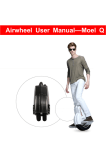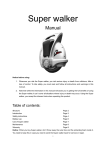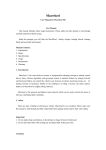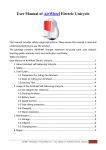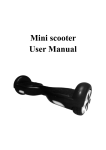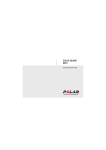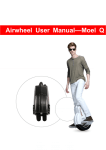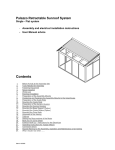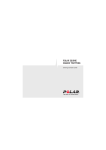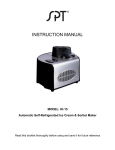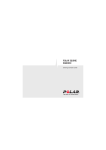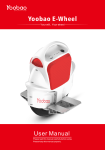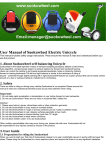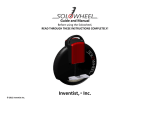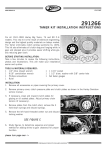Download USER MANUAL - Grossiste chinois import
Transcript
USER MANUAL 1. Introduction Airwheel is the state-of-the-art means of transportation adopting aerospace attitude control theory, fuzzy software algorithm, and gyroscope system to maintain balance by leaning forward and backward. Riders can control the vehicle to go forward, accelerate, decelerate, brake, etc. by leaning forward or backward. Similar to the techniques of riding a bicycle, the riders achieve balance on Airwheel by slightly tilting sideways. Airwheel is the greenest and lightest smart unicycle which can be easily carried into buses or subways, facilitating daily commuters. 2. Safety There are risks of riding or driving any vehicle. Airwheel is no exception. Please make sure this manual is read through and fully understood before getting started, and be alert when riding. Important Note: 1. Sharp acceleration or deceleration or speeding via overly leaning forward or backward are strictly forbidden. Do not accelerate when power level indicators show only one bar left, please recharge your Airwheel asap. 2. Do not ride Airwheel when risking any accidental falls. Safety goes first. Attention: 1. Do wear helmet, gloves, elbow/knee pads or other necessary protection gears. 2. Do not ride Airwheel on packed roads or crowded streets with motorized vehicles. 3. Do not ride Airwheel on rough or bumpy surfaces, such as muddy or gravel roads. 4. Do not ride Airwheel on wet, slippery surfaces, especially icy ones. 5. Do not ride Airwheel on slopes of over 15° gradient. 6. Do not allow children under 15 to ride Airwheel. 7. Do not ride Airwheel in bleak winter conditions. Other unpredictable risks may occur during usage, please ride with caution. Airwheel will not take responsibilities for any injuries caused by misuse of the product. 2.1 Safety Guidelines and Riding Etiquettes Please learn and abide by local laws and regulations when riding Airwheel. Be careful and considerate of others, and take precaution of accidents and collisions. Please ride at safe and proper speed and make sure your Airwheel is under control. Keep yourself a safe distance from pedestrians and vehicles and always be prepared to stop. Respect pedestrians and avoid startling pedestrians, especially children. When approaching from behind, announce yourself and slow down to walking speed when passing. Pass on the left whenever possible. When approaching a pedestrian from the front, stay to the right and slow down. Keep a safe distance from other Airwheel riders and always avert from obstacles. Unless there’s ample space for other pedestrians, please do not ride side by side with fellow Airwheel players. Please avoid riding in poor light unless necessary, and make sure in this scenario you ride at slow, safe speed with care and geared with mounted driving lights if possible. Please relax your body when riding, bend your knees and elbows slightly and look straight forward. Riding backward can be dangerous. For emergency, ride slowly backward in necessary avoidance of obstacles. Please lean forward slightly to accelerate instead of lunging forward suddenly. You may lose balance and get yourself hurt in aggressive acceleration. It is the main cause of accidental falling overs. 2.2 Initiative Safety Measures Please read through this manual and make sure it is fully understood. Do not allow others try your Airwheel, unless he/she has read through this manual. Please do wear safety gears while riding Airwheel. Make sure your helmet is comfortably fit and qualified for safety protection. Riders may wear glasses, elbow/knee pads according to their own experiences. Please do not ride Airwheel when you are under the weather or affected by alcoholic/drugs and not able to follow the instructions on the manual. Please stop riding immediately when Airwheel starts alerting for low battery or over speed. Charge your Airwheel in time to ensure safe and smooth usage. Make sure to power off Airwheel before moving it. Do not lift Airwheel on the wheel in case your fingers get caught between the tire and case. Check your Airwheel carefully for any loosened or damaged parts every time prior to usage and do not ride before proper troubleshooting. 3. Airwheel Learning Tips 3.1 Before Getting Started For first-timers, be sure to equip yourself with comfortable sportswear and sneakers. Warm up your body and keep your body agile. Considering the average human athletic skills, the height of pedal is set 10cm from ground only, which guarantees your safety in case of falling over. A Helmet, gloves, knee and ankle pads are also essential for first-timers. To start, please bring Airwheel to open space and watch out for obstructions and bumpy terrains. 3.2 Learning Tips for First-Timers 1. Place Airwheel vertically on the ground by one hand and power it on. 2. Unfold the pedals and straddle Airwheel. 3. Place one foot on the center of a pedal and bend the leg slightly to press on the cushion rubber tightly. 4. Lift your hand that holds Airwheel, stand upright naturally and look straight forward. Shift your body weight to the leg standing on the ground and try to achieve lateral balance. 5. Maintain this position and shift your body weight gradually to the other leg and lift your supporting leg from the ground and try to maintain momentary balance. 6. Please follow and practice the above steps before starting gliding with one foot on a pedal. 7. After being able to glide with one foot smoothly, place another foot on a pedal and relax your legs for better balance. 8. Ride along and try to change directions by shifting body weight or twisting your waist slightly. 3.3 Important Note Training belt is highly recommended for first-timers, which reduces risk of falling over. Warnings 1. Players under 18 or over 45 are supposed to find your learning partners. 2. Make sure to check the power level and tire before riding. 3. Please control speed before riding smoothly. 4. Usage 4.1 Component 1. Power Button 2. Power Level Indicators 3. Charge Connector 4. Paddle 4.2 Getting Started Place Airwheel vertically on the ground and turn it on. The Power Level LED Indicators will be on and the buzzer will beep, and the unit is ready to be used. If Airwheel tilts either forward or backward after powered on, please wait until it adjusts to upright position before riding. 4.3 Power Level A four-bar LED indicator is applied to indicate the power level. All fours will be lit when power level is over 85% and will go off one by one as the level drops. Please check power level every time before usage to ensure there is enough power for a return trip. You may recharge it every time after usage. When power level falls lower than 15%, all four lights will blink and the buzzer will beep. The front end of the paddle will sink to force you to decelerate and eventually stop. Please do not attempt to ride again, otherwise you may suffer a sudden loss of power and fall over. Duration range will be limited during winter, since the battery performance drops sharply in cold weather. For instance, at -15℃, the discharge capacity is only about half compared to that at room temperature. 4.4 Speed Control To prevent injuries caused by overspeed, Airwheel sets a maximum speed. When speed exceeds 12km/h, the front end of the pedal will rise gradually and when the speed exceeds 16km/h, the pedal will pose a 10°angle to the leveling surface, which stop you from inclining further to accelerate. The pedal will flatten itself gradually as the speed decreases. NOTE: Please do not incline further to accelerate when approaching the maximum speed. 4.5 Tilting Protection When Airwheel tilts to over 45°sideways, e.g. when Airwheel turns over, the control system will activate tilting protection. The motor will stall immediately to prevent injuries. The buzzer will start a long buzz and the LED indicators will flash at the same time. To deactivate this, power off the unit to reboot. 4.6 Charging the Battery Power on the A/C source after plugging in the charger, otherwise the charger will stop working to avoid charging safety. Airwheel is equipped with a high-power charger. Normally it takes about 90-250 min to be fully charged and 60-160 min to 80% full (check the specification table for detailed info). The indicator lights will turn red when charging and green when charging completes. If not for emergencies, please wait until charging completes before unplugging, for battery protection board will conduct SOC equalization as charging completes. 4.7 Water Resistance Airwheel is featured with lP56 water-proof rating, which sails safely in 10mm (or below) of water. You may ride it in drizzles shortly, yet avoid sinking it in deep water or riding it on rainy days for a long time. 5. Maintenance 5.1 Storage Please store Airwheel in a dry location. For non-regular users, recharge the battery every 90 days to maintain the battery life and store Airwheel only after it's fully charged. 5.2 Inflation Use the extended connector to inflate the tire. Without the connector, you may fail to pump air into the wheel. 5.3 Changing the Tire To repair or change the inner or outer tire, open one side cover (the one without indicator lights). First, unscrew the 14 bolts on the sides, then the 6 bolts on the center, and then open the casing. Take special care with the connecting wires set alongside the inner rim, no dragging or cracking open. Note: A. Electric Sparks may flash momentarily at the end of the power cord after maintenance. That is normal and no need to panic. B. Do not open the cap on the side cover with indicator lights. Any Malfunction or damage caused by opening parts unspecified in this manual will not be covered by the warranty. 6. Warranty Please retain the warranty and proof of purchase (i.e. receipt). Limited Warranty Terms (Non-Artificial Damage Only): 1. 1 year for the main body (battery and other wearing parts not covered). 2. 6 months for battery and l month for inner and outer tires. The following situations will not be covered by the warranty: 1. Malfunction due to misuse. 2. Malfunction caused by unauthorized modifications, disassembling, or repair. 3. Accidental damage or malfunction due to improper storage. 4. Discrepant warranty/proof of purchase and product. 5. Exterior damages due to usage. 6. Disassembling parts unspecified by this manual. 7. Damage or malfunction caused by riding on rainy days or dipping in water.



